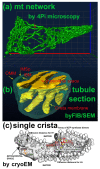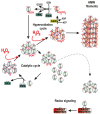Pitfalls of Mitochondrial Redox Signaling Research
- PMID: 37759999
- PMCID: PMC10525995
- DOI: 10.3390/antiox12091696
Pitfalls of Mitochondrial Redox Signaling Research
Abstract
Redox signaling from mitochondria (mt) to the cytosol and plasma membrane (PM) has been scarcely reported, such as in the case of hypoxic cell adaptation or (2-oxo-) 2-keto-isocaproate (KIC) β-like-oxidation stimulating insulin secretion in pancreatic β-cells. Mutual redox state influence between mitochondrial major compartments, the matrix and the intracristal space, and the cytosol is therefore derived theoretically in this article to predict possible conditions, when mt-to-cytosol and mt-to-PM signals may occur, as well as conditions in which the cytosolic redox signaling is not overwhelmed by the mitochondrial antioxidant capacity. Possible peroxiredoxin 3 participation in mt-to-cytosol redox signaling is discussed, as well as another specific case, whereby mitochondrial superoxide release is diminished, whereas the matrix MnSOD is activated. As a result, the enhanced conversion to H2O2 allows H2O2 diffusion into the cytosol, where it could be a predominant component of the H2O2 release. In both of these ways, mt-to-cytosol and mt-to-PM signals may be realized. Finally, the use of redox-sensitive probes is discussed, which disturb redox equilibria, and hence add a surplus redox-buffering to the compartment, where they are localized. Specifically, when attempts to quantify net H2O2 fluxes are to be made, this should be taken into account.
Keywords: H2O2 release into intracristal space; MnSOD; cytosolic H2O2 release; matrix H2O2 release; peroxiredoxins; redox buffers; redox signaling from mitochondria; redox-sensitive probes.
Conflict of interest statement
The author declares no conflict of interest.
Figures




Similar articles
-
Mitochondrial Physiology of Cellular Redox Regulations.Physiol Res. 2024 Aug 30;73(S1):S217-S242. doi: 10.33549/physiolres.935269. Epub 2024 Apr 22. Physiol Res. 2024. PMID: 38647168 Free PMC article. Review.
-
Integration of superoxide formation and cristae morphology for mitochondrial redox signaling.Int J Biochem Cell Biol. 2016 Nov;80:31-50. doi: 10.1016/j.biocel.2016.09.010. Epub 2016 Sep 15. Int J Biochem Cell Biol. 2016. PMID: 27640755 Review.
-
Glucose Acutely Reduces Cytosolic and Mitochondrial H2O2 in Rat Pancreatic Beta Cells.Antioxid Redox Signal. 2019 Jan 20;30(3):297-313. doi: 10.1089/ars.2017.7287. Epub 2018 Jun 14. Antioxid Redox Signal. 2019. PMID: 29756464
-
The Mitochondria-to-Cytosol H2O2 Gradient Is Caused by Peroxiredoxin-Dependent Cytosolic Scavenging.Antioxidants (Basel). 2021 May 6;10(5):731. doi: 10.3390/antiox10050731. Antioxidants (Basel). 2021. PMID: 34066375 Free PMC article.
-
Monitoring cytosolic H2O2 fluctuations arising from altered plasma membrane gradients or from mitochondrial activity.Nat Commun. 2019 Oct 4;10(1):4526. doi: 10.1038/s41467-019-12475-0. Nat Commun. 2019. PMID: 31586057 Free PMC article.
Cited by
-
Mitochondrial Management of ROS in Physiological and Pathological Conditions.Antioxidants (Basel). 2025 Jan 2;14(1):43. doi: 10.3390/antiox14010043. Antioxidants (Basel). 2025. PMID: 39857377 Free PMC article.
-
Light Emission from Fe2+-EGTA-H2O2 System Depends on the pH of the Reaction Milieu within the Range That May Occur in Cells of the Human Body.Molecules. 2024 Aug 25;29(17):4014. doi: 10.3390/molecules29174014. Molecules. 2024. PMID: 39274863 Free PMC article.
-
Mitochondrial Physiology of Cellular Redox Regulations.Physiol Res. 2024 Aug 30;73(S1):S217-S242. doi: 10.33549/physiolres.935269. Epub 2024 Apr 22. Physiol Res. 2024. PMID: 38647168 Free PMC article. Review.
-
Primary Roles of Branched Chain Amino Acids (BCAAs) and Their Metabolism in Physiology and Metabolic Disorders.Molecules. 2024 Dec 27;30(1):56. doi: 10.3390/molecules30010056. Molecules. 2024. PMID: 39795113 Free PMC article. Review.
References
Publication types
Grants and funding
LinkOut - more resources
Full Text Sources
Research Materials

